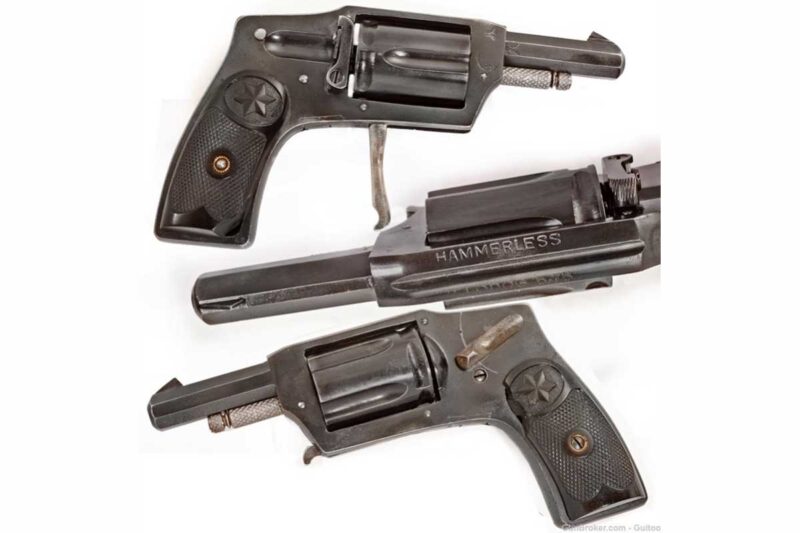
By David Parris, GunBroker.com Writer
If you’ve browsed around GunBroker.com for any amount of time, especially the Collectible Firearms, you’ve probably scrolled over some Velo-Dog Revolvers (or Velodogs). You may have noticed that they seem to share some common characteristics. Velo-Dogs are usually old European pocket revolvers with short barrels under 2 inches. They tend to be “hammerless,” although that’s a misnomer since it’s actually a shrouded hammer, making them double-action-only revolvers. Those weird little folding triggers may have caught your eye, too. So what are these Velo-Dog revolvers, anyway? Interestingly, most of them aren’t really Velo-Dogs at all.
What is the History of the Velo-Dog Revolvers?
Although the history is a little foggy, they were invented by Charles-François Galand circa 1894 and trademarked as “Velo-Dog” by his son René Galand in 1904. Many reference René as the original designer, which puts the question squarely into the realm of family matters, which are best left alone if you’re not a Galand. They were in a class of pocket pistols called the “Revolver de Poche.” The “de Poche” doesn’t translate from French to “the Pooch” though, it means “small pocket,” so the English translation is “Small Pocket Revolver.”
The name “Velo-Dog” comes from the word “velocipede,” what they called bicycles back then, and “dog.” The Velo-Dog revolver was designed for a somewhat odd and singularly specific purpose: for cyclists to ward off attacking dogs. Ever had a dog clamp onto your leg while you were riding a bike? If so, you can immediately see why such a thing would sell well in an era when cycling was an increasingly common form of personal transportation and dogs, feral or otherwise, pretty much ran amok.
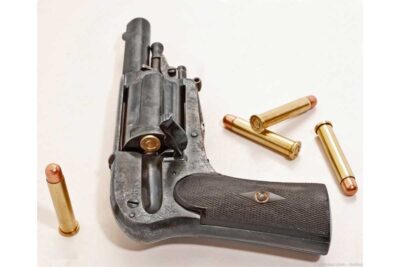
Although there were a few early single-action revolvers, the idea of the hammerless design was to be able to pull it out of your pocket quickly without snagging, and a traditional hammer doesn’t fit the bill. There were also early models that had traditional triggers and trigger guards, but the folding trigger was far more streamlined for carrying in a vest pocket and offered even less chance of hanging up when they were being drawn. Many models had a manual safety lever on the left side that was generously large and easy to disengage. Although they had cylinder gates and an ingenious little pull-out shell ejection rod tucked into a swiveling yoke that also served as the cylinder pin, reloading them was slow and it’s unlikely that anyone would attempt it while riding a bike.
But what kind of monster would shoot a dog just for doing normal dog stuff? Even though the late 19th century/early 20th century wasn’t a period in history when animal welfare was really a thing, the Velo-Dog still took it into account. The cartridge design was a conscious effort to be humane to vicious dogs. The concept was never to kill a dog, but to scare it off with a loud noise and a nonlethal physical deterrent that wasn’t seriously injurious to pugnacious pups. So, how did they pull that off?
The 5.75mm Velo-Dog Calibre cartridge is a strange beast (pun intended). It doesn’t even seem like ammo manufacturers could settle on a caliber designation since some boxes were marked as “5.5mm Velo-Dog” or “6mm Velo-Dog,” and many were simply marked “Velo-Dog Calibre,” even though they were all the same thing. This may well have been to dance around “5.75mm Velo-Dog” being Galand’s proprietary caliber. It’s a 5.5×29.6mmR (rimmed) straight-walled centerfire cartridge, which is a questionable choice given that rimfire technology was already prevalent in pocket revolvers dating back to the 1850s (Smith & Wesson Model 1). The centerfire primer takes up most of the base diameter, and it looks very much like a rimfire .22 Mag cartridge (although the .22 Mag wasn’t invented until 1959). For comparison, the 22 Mag is a 5.8×26.8mm rimfire, so the Velo was a narrower bullet with a longer case and a whole lot less power.
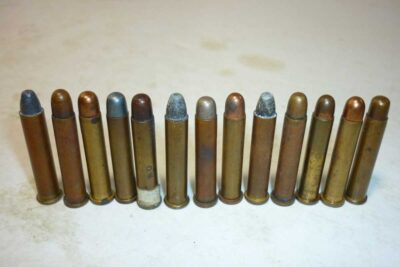
The Velo-Dog cartridge was intentionally anemic, the first component of this oddball gun’s consideration for canines. Velo-Dog revolvers were also sometimes smoothbores, making them wildly inaccurate at anything past spitting distance. Plus, if you’re riding a bike while shooting a gun in the general direction of your flailing leg under a high-stress situation, the chances of literally shooting yourself in the foot are quite high. Plainly put, Velo-Dogs were wimps that couldn’t beat a 22 Short in a fair fight. Using some rough averages, here’s how they stack up against common modern pipsqueaks:
- 5.75mm Velo-Dog Calibre (5.5×29.6mmR), 45gr bullet, 650 fps MV (Muzzle Velocity) & 42 ft-lb ME (Muzzle Energy)
- 22 Short (5.6×10.7mm), 29gr bullet, 980 fps MV & 71 ft-lb ME
- 22 Long Rifle (5.73×15.6mm), 40gr bullet, 1,200 fps MV & 131 ft-lb ME
- 22 Magnum (5.8×26.8mm), 50gr bullet, 1,530 fps MV & 300 ft-lb ME
The next ammo innovation for Velo-Dog cartridges was the variety of projectiles that were offered. The standard was an FMJ (full metal jacket) and almost all of the surviving vintage Velo-Dog ammo you’ll find is the same. Although lead bullets were also offered, a wide selection of wood, wax, and cork bullets were available. There were also shotshells loaded with cayenne pepper, very small shot (lead dust), and similar doggy deterrents. As if it wasn’t weak enough, there were even 5.5mm Velo-Dog Short (or 5.75 Velodog Short) cartridges. Modern-manufactured 5.75mm Velo-Dog ammo from Fiocchi is still floating around, although discontinued and not offered in anything more exotic than a basic 43gr FMJ (still easier to find than vintage cartridges and you might consider firing a few).
What is a “True” Velo-Dog?
The Galand company’s workshop was in Liège, Belgium, which was an area that produced all kinds of firearms from different manufacturers large and small. Soon enough, other gunmakers from all over Western Europe began making their own Velo-Dogs, many of which were unmarked except for proof stamps, likely as a trademark dodge. There were a ton of models billed as “bicycle guns” and “Velo-Dogs.” Many of these competitors were Belgian, but plenty also came out of Germany, Spain, and France. It’s very difficult to pin down any evidence of any American commercial gunmakers ever producing a true Velo-Dog. If you run across an American true Velo, bid ‘til it hurts.
But it isn’t the Galand brand that makes a “True Velo-Dog.” It’s also not just the design elements like the hammerless frame or the folding trigger, either. In the general collector’s community, only the caliber makes it a true Velo. As the 6.35mm/.25 ACP gained popularity for pocket pistols, production quickly switched over from the Velo-Dog Calibre. So quickly that original Velo frames and the same long cylinders were used as a result, with subsequent variants using shorter frames and cylinders suitable to the shorter-caliber cartridges. This makes it tricky to identify a true Velo from an imposter just by looking at it because it could very well be a 6.35mm using the long cylinder of the Velo-Dog Calibre. Just because it says it’s a Velo-Dog doesn’t make it a Velo-Dog. There were a lot of calibers employed by the imposters misappropriating the name, including 7.65mm, .320, 8mm, and more.
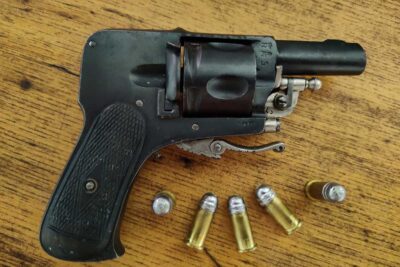
The imposters were intended to be highly concealable EDCs for two-legged attackers in urban areas where carrying firearms discretely was a necessity. The effectiveness of the diminutive guns is dubious and served more as a reassuring comfort to the carrier than a viable self-defense weapon. There’s an old saying, “.22 Short only kills by lead poisoning,” and it’s true of most of the old pocket pistols. These kinds of firearms are also known as “mouse guns,” “get off me guns,” and “belly guns.” North American Arms (NAA) is the only company currently manufacturing mini-revolvers on a wide scale, notably the tiny five-shot .22 Short NAA-22S, with a 1-⅛-inch barrel, 3.63-inch overall length, 2.38-inch height, 0.88-inch width, and weighing in at just 4 ounces.
As a trivial final footnote on these very odd little revolvers, “Vestigial Limb,” an obscure electronic-abstract-experimental band, put out a song (EP? album? hard to tell with that kind of music) named “Velo Dog Dissuader” in 2010. Definitely not this author’s cup of tea, but points for the name at least.
Related Articles: Top 22 Most Expensive Guns Sold on GunBroker – August 2023
Related Videos: Highlights of the Trailblazer LifeCard – Single-Shot Pocket Firepower [Video]
Related Articles: New Pocket Pistol Releases: Beretta, Ruger, Smith & Wesson and More
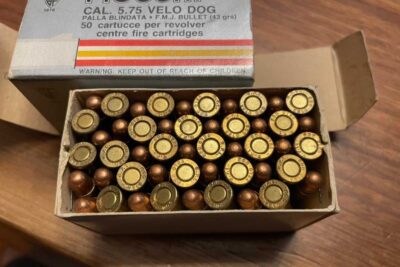
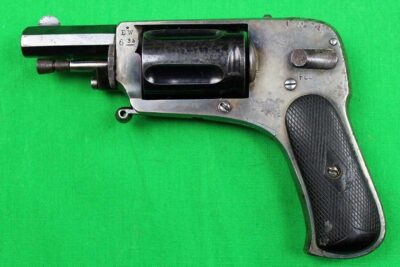
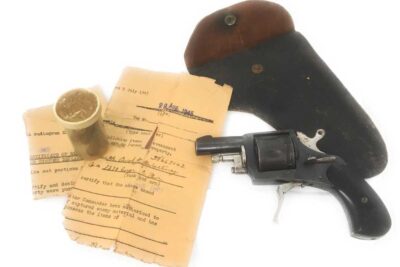

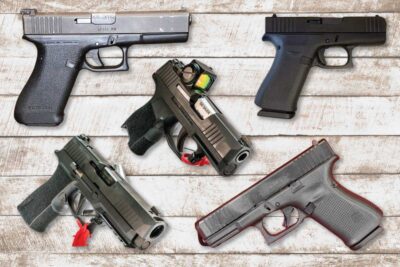

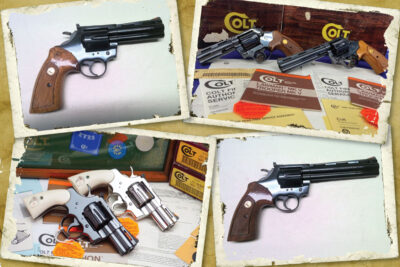



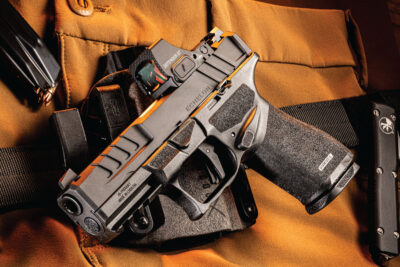
![New for 2025: EAA Witness2311 Match and Witness2311 Match X Double Stack [Video]](https://qacontent.gunbroker.com/wp-content/uploads/2025/02/EAA-Witness2311_Match-doublestack1911_2-1-400x267.jpg)
![1301 Tactical Shotgun Customized with LTT Heat Shield and Labyrinth [Video]](https://qacontent.gunbroker.com/wp-content/uploads/2025/01/Langdon_1301_Tactical-LTT-Heat-Shield-with-Labyrinth_2-400x267.jpg)
![At The Ready Custom Pistol Mounts: What You Need to Know [Video]](https://qacontent.gunbroker.com/wp-content/uploads/2025/03/At_The_Ready_Mounts-featured-400x267.jpg)
![3 Must-Have Altamont Engraved 1911s [VIDEO]](https://qacontent.gunbroker.com/wp-content/uploads/2025/01/Altamont_Master_Scroll_Rampant_Colt1911-400x267.jpg)